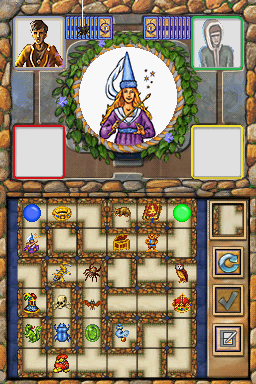Wide variety of multiplayer modes; dedication to original Ravensburger game
Bland graphics; sometimes silly writing
From Independent Arts Software and Mentor InterActive comes Labyrinth, not to be confused with by an earlier Labyrinth game based on Taito’s Cameltry. This particular release is an adaptation of Ravensburger Spieleverlag GmbH’s board game originally titled “A-MAZE-Ing Labyrinth”, now more sanely titled “Labyrinth”, which may be unfamiliar to American audiences. Essentially, it’s a board game wherein up to four players must traverse a maze in order to find treasures spread throughout, while building the maze as they go. Players do not know what treasures the other players are looking for, though they can certainly guess– meaning they’ll also try to trap other players in dead ends or drive them away from treasure, all while advancing themselves to their own sought treasures. Needless to say, like many other European board games, Labyrinth is a brain-bender, making the stylus-controlled DS version a great choice for Mentor Interactive’s “thinkSMART” label. It certainly gives another meaning to DS “brain training” games.
While its production values seem relatively low– the two-dimensional graphics are static for the most part and a bit drab– that’s not what the draw of Labyrinth is. Ravensburger’s game is already complete, after all, and complex enough without any distracting graphics. That said, Interactive Arts did see fit to hire a composer whose music is fairly appropriate, with a grand symphonic opening reminiscent of any high-caliber adventure game and a calculating puzzle-solving mix that manages to drive players sane rather than insane (a good thing in a thinkSMART game). It’s true, though, that these pieces are not necessarily memorable by themselves–there’s no Tetris-esque “Music A” here– but they certainly become memorable in the earworm sort of way after necessarily listening to them for hours. While this seems like a no-brainer, it’s actually very much appreciated in an oversaturated market full of casual game developers which assume a few randomly placed beeps and boops constitute “music”. (We’d like to remind these developers that John Cage does not always have a place in video game music.)
 That said, it’s not difficult to say that there wasn’t much room to begin with to add or remove from the original Labyrinth experience, especially on DS. Like adaptations of Settlers of Catan or, God forbid, Monopoly before it, Labyrinth for DS is simply the original board game gussied up with Indiana Jones-esque visuals and a somewhat interesting mystery-adventure-based Campaign Mode. (The former uses the original board game graphics, with grinning genies and ominous skulls among the “treasure” players must find; the latter is slightly cheesy, involving boy detective/archaeologist Alok’s quest to find his kidnapped father, Bhaskar Datthanie.) However, the story mode nevertheless prepares players for true Labyrinth greatness, even if it is just a string of matches interrupted with brief story snippets; if players don’t feel like going through the story, there’s also a convenient “Quick Match” option that sends them right into the fray. Again, however, while Labyrinth is perfect for Nintendo DS– to imagine this very tactile game on any other system is almost torturous– it’s also really just a digital board game, albeit with an attempt at making things interesting with a story.
That said, it’s not difficult to say that there wasn’t much room to begin with to add or remove from the original Labyrinth experience, especially on DS. Like adaptations of Settlers of Catan or, God forbid, Monopoly before it, Labyrinth for DS is simply the original board game gussied up with Indiana Jones-esque visuals and a somewhat interesting mystery-adventure-based Campaign Mode. (The former uses the original board game graphics, with grinning genies and ominous skulls among the “treasure” players must find; the latter is slightly cheesy, involving boy detective/archaeologist Alok’s quest to find his kidnapped father, Bhaskar Datthanie.) However, the story mode nevertheless prepares players for true Labyrinth greatness, even if it is just a string of matches interrupted with brief story snippets; if players don’t feel like going through the story, there’s also a convenient “Quick Match” option that sends them right into the fray. Again, however, while Labyrinth is perfect for Nintendo DS– to imagine this very tactile game on any other system is almost torturous– it’s also really just a digital board game, albeit with an attempt at making things interesting with a story.
This is especially apparent in its multiplayer modes, which eschew Nintendo Wi-Fi Connection for simple LAN play. Yet this doesn’t come as too much of a downfall either, considering most of the fun involved in any board game is the witty banter between friends throughout, which should come in strong supply in Labyrinth‘s offered Multi-Card and Download Play modes for up to four players. (Again, Interactive Arts takes advantage of almost every ability the DS has, which is a refreshing change of pace that once again separates Labyrinth from other casual games which seem to think every player will always have multiple game cards.) Labyrinth even offers hotseat play, which is much-welcomed considering not everybody has a DS system even years after its release. Multiplayer offers essentially the same game as Labyrinth‘s single-player mode– no crazy battle modes here. But again, in a game like Labyrinth, their brains are the only weapons players will need.
While it doesn’t really do any different from the original board game, Labyrinth offers a rousing game of wits fit for any board game or puzzle enthusiast. Since Ravensburger’s original game is pretty difficult to acquire in the United States, Interactive Arts and Mentor InterActive’s version is a perfect substitute– and for a bargain price.
Nintendojo was provided a copy of this game for review by a third party, though that does not affect our recommendation. For every review, Nintendojo uses a standard criteria.




 ShareThis
ShareThis






